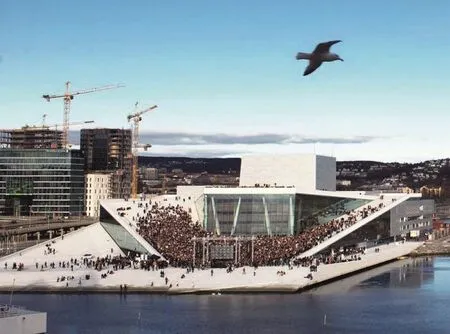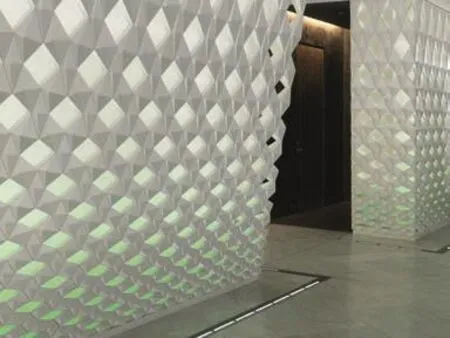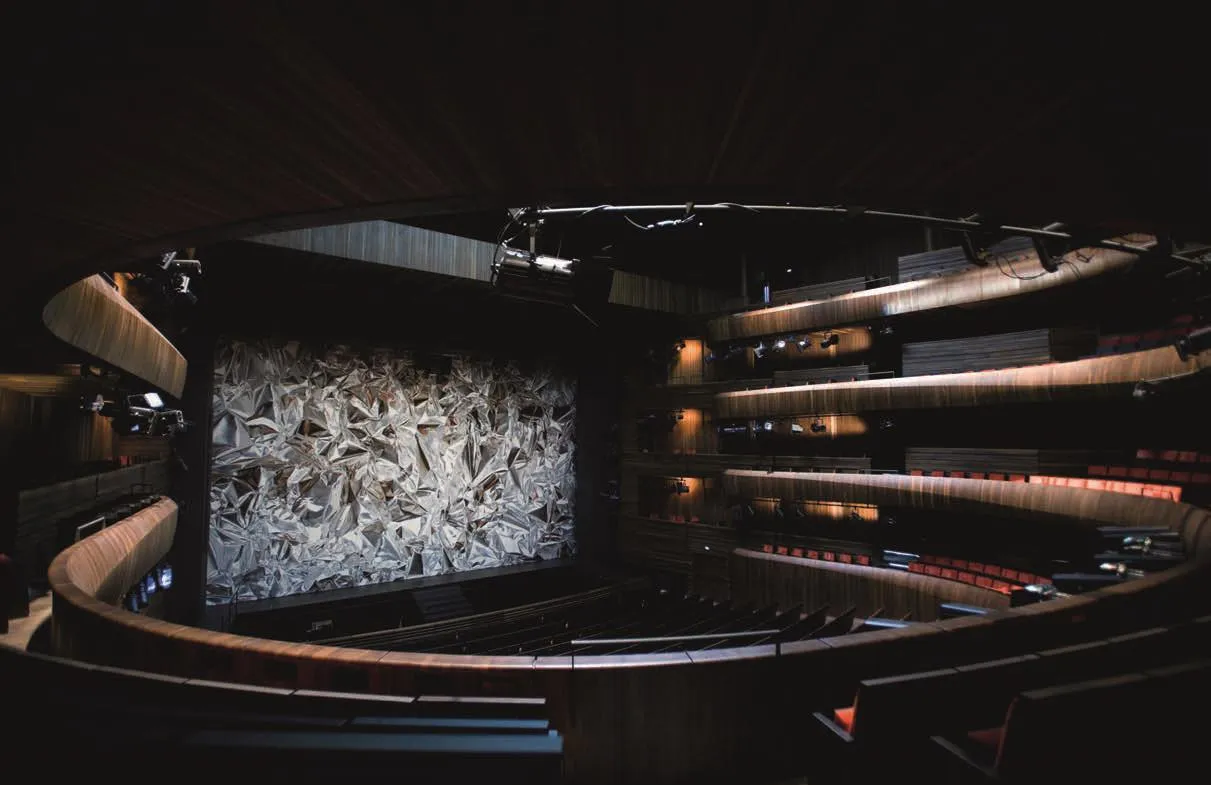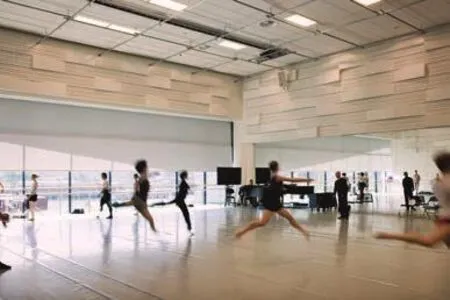挪威国家歌剧与芭蕾舞剧院,奥斯陆,挪威
2018-09-26建筑设计斯诺赫塔建筑事务所
建筑设计:斯诺赫塔建筑事务所

1 凹形坡/Sunken grooves

2 外景/Exterior view
2008年12月1日——该项目将极为复杂的功能整合到一个简单的总平面中,将既实用又直观的造型手法用于外形的塑造上。低垂的形式与城市内部融为一体,而不是一种突兀的造型表达。可登临的屋顶与宽敞的公共大堂使建筑成为供人社交的纪念性建筑,而不是一座雕塑。
歌剧院既是一处景观也是一座建筑,这就会培养公众意识,促使人们欣赏艺术。街道层上的大窗让公众能一睹布景工作室内的风采。建筑也会吸引不熟悉歌剧、芭蕾和管弦乐的听众。可通向水边的咖啡厅和礼品店,既可以为歌剧院营收,又能给公众提供便利。这些部分的设计非常仔细,以使它们与建筑大胆设计的整体特色结合得天衣无缝。
这座歌剧院由一个竞赛获奖方案建成。方案中的4个图示说明了建筑的基本概念。
“海浪之墙”
歌剧和芭蕾在挪威都是新兴的艺术形式,它们是在国际环境中不断发展的。比约维卡半岛是港口城市的一部分,在历史上是与世界各地交汇的地方。“此岸”的陆地与“彼岸”的海水之间的界线既是现实中的又是象征性的。这个界线被建成三重交界线上的一面大墙——海水与陆地、挪威与世界、艺术与日常生活,这也是公众走进艺术的界线。
“创作工厂”
竞赛编制了详细的任务书作为基础。斯诺赫塔提出:歌剧院的创作设施要建为自成一体、设计理性的“工厂”。这座工厂在设计阶段以及后期使用中应当既实用又灵活。这种灵活性被证明在设计阶段是非常重要的:许多房间和房间组合在与最终用户的合作下进行了调整。这些调整在不影响建筑本体的情况下提高了实用性。
“屋顶地毯”
竞赛任务书要求歌剧院具有很高的建筑品质和纪念性的表达。一组概念作为这种纪念性的根据是引人注目的:亲密无间、产权共有、对所有人开放便捷。为了实现以这些概念为基础的纪念性,我们希望在建筑顶部铺一条由水平面和斜面组成的“地毯”,让歌剧院尽可能便捷。这条地毯被赋予一种与城市景观相结合的整体形式。这种纪念性是通过水平延伸而非垂直性实现的。
这次竞赛的概念基础以及最终的建筑综合了这三种因素——海浪之墙、创作工厂和屋顶地毯。□(尚晋 译)

3 外景/Exterior view
Monday, December 1, 2008 – The project developed a highly complicated programme into a simple general plan that integrated both a practical and intuitive sculptural approach to modeling the exterior form. Its low slung form became a link within the city rather than a divisive sculptural expression. Its accessible roof and broad, open public lobbies make the building a social monument rather than a sculptural one.
The building is as much landscape as architecture and thus fosters public awareness and engagement with the arts. Generous windows at street level provide the public a glimpse of the scenery workshop activities. The building still finds an audience with public who are not opera, ballet or orchestra fans. The cafes and gift shop,with their access to the waterfront are destinations which offer opportunities to generate revenue for the institution while providing a general public amenity.Care was taken with the design of these components so that they are seamlessly integrated into the overall character of the building's bold design.
The opera house is the realisation of the winning competition entry. Four diagrams, which were part of the entry, explain the building's basic concept.
"The Wave Wall"
Opera and ballet are young art forms in Norway.These art forms evolve in an international setting. The Bjørvika peninsula is part of a harbour city, which is historically the meeting point with the rest of the world.The dividing line between the ground "here" and the water "there" is both a real and a symbolic threshold.This threshold is realised as a large wall on the line of the meeting between land and sea, Norway and the world, art and everyday life. This is the threshold where the public meet the art.

4 外景/Exterior view

5 内景/Interior view
项目信息/Credits and Data
客户/Client: 教会及文化事务部/Ministry of Church and Cultural Affairs
地质工程师/Geological Engineer: NGI
结构工程师/Structural Engineer: Reinertsen Engineering ANS
电气工程师/Electrical Engineer: Ingeniør Per Rasmussen AS
艺术家及艺术品统筹/Artists, Integrated Artwork: Kristian Blystad, Kalle Grude, Jorunn Sannes, Astrid Løvaas og Kirsten Wagle
承包商/Contractors: 55 contracts
剧院规划/Theatre Planning: Theatre Project Consultants
声学/Acoustics: Brekke Strand Akustikk, Arup Acoustic
面积/Area: 38,500m2
摄影/Photos: Erik berg (fig.1,2,5,9,11,12), Jens Passoth(fig.3), Trond Isaksen, Statsbygg (fig.4), Gerald Zugmann(fig.6,10), Jiri Havran (fig.13,14)
线图/Drawings: Snøhetta

6 外景/Exterior view
"The Factory"
A detailed brief was developed as a basis for the competition. Snøhetta proposed that the production facilities of the opera house should be realised as a selfcontained, rationally planned "factory" . This factory should be both functional and flexible during the planning phase as well as in later use. This flexibility has proved to be very important during the planning phase: a number of rooms and room groups have been adjusted in collaboration with the end user. These changes have improved the buildings' functionality without affecting the architecture.
"The Carpet"
The competition brief stated that the opera house should be of high architectural quality and should be monumental in its expression. One idea stood out as a legitimisation of this monumentality: the concept of togetherness, joint ownership, easy and open access for all. To achieve a monumentality based on these notions we wished to make the opera accessible in the widest possible sense, by laying out a "carpet" of horizontal and sloping surfaces on top of the building.This carpet has been given an articulated form, related to the cityscape. Monumentality is achieved through horizontal extension instead of verticality.
The conceptual basis of the competition, and the final building, is a combination of these three elements –The wave wall, the factory and the carpet. □

7 平面/Plan

8 立面/Facade
评论
龙灏:和很多尺度巨大、拒人千里的公共性、纪念性建筑不同,建筑师在挪威国家歌剧与芭蕾舞剧院的设计中反其道而行之,将该建筑的体量结合内部功能的组织通过切块的手法进行了体量消解,并且在临海一面直接将屋面倾斜直插入海,为市民提供了一个巨大的、可与建筑“亲近”的、开放的公共空间,同时自身也成为了港口中一道独特的景观。建筑在材料色彩的运用上也颇具匠心,外观以白色、透明为主,而室内则在很多同类建筑都会采用的木质面层材料的组合上结合灯光布设进行了设计处理,大厅楼梯一侧是厚重的木质栏板,而另一侧却是轻薄的白色玻璃,凸显了建筑师设计时的放松与俏皮。
范路:对挪威国家歌剧与芭蕾舞剧院建筑来说,从海面开始上升转折至屋顶的斜坡是主要设计特色。这种形式语言,把建筑与景观、纪念性与公共性、竖直向与水平向、表演艺术与日常生活整合在了一起。而斜坡四周围栏的处理方式同样回应了这种多义整合的特性。室外斜坡与围栏墙体没有直接相交,而是留出下沉的凹槽。这些凹槽作为阶梯或坡道,在边缘形成了快捷路线,以减少对于斜坡上休闲活动的干扰。凹槽中设置了灯光,在夜晚照亮了斜坡的造型轮廓。而在白天,下沉处理削弱了围墙的竖向尺度,带来斜坡可以向四周延伸出去的意向。还要提及的是,歌剧院室内休息厅中台阶栏板的处理也延续了这种多义逻辑。台阶梯段和外侧栏板用橡木饰面,与表演厅外部的木质“波浪墙”连为一体。而台阶另一侧的围栏却由浅白色半透明玻璃构成,以柔和的方式呼应了休息厅中的白色柱子和灰白色地面与天花。


9.10 内景/Interior views
Comments
LONG Hao: Unlike many public and monumental buildings which are large-scaled and inaccessible,the architects did the opposite in the design of the Norwegian National Opera and Ballet. By dicing method, the volume of the building is dissolved in combination with the organization of internal programs.To the seaside, the sloped roof thrusts directly into the sea, creating a huge but closely interactive open space for the public and making itself some unique landscape in port. The colours used for the architecture materials are also very ingenious: The outer appearance is mainly white and transparent, while timber surface material often used in many similar cases is adopted for the interior, but subtly composed and designed in parallel with the lighting disposition. The parapet on one side of the staircase in the great hall is made by thick wooden boards, yet the parapet on the other side is made by thin white glass plates, highlighting the relaxed and playful attitude of the architects while designing it. (Translated by CHEN Xi)

11 舞台/Stage
FAN Lu: The architecture of Norwegian National Opera and Ballet locates in the fjord of Bjørvika, Oslo, which features walkable slanted roof decks stretching from the sea level to the building top.Through these expressive formal languages, multiple dimensions are integrated as a whole -architecture and landscape, monumentality and publicity, verticality and horizontality, performing arts and daily lives. The multi-dimensional and integrative strategy is manifested in outdoor parapet design, in which the slanted roof slabs join up the fencing walls with sunken grooves. Those grooves serve as stairs or ramps, providing passways along the roof edge and separating circulation from resting areas. Illuminating system is set in grooves which highlights the confines of the roofs at night.While by day, the sunken disposal reduces the scale of fencing walls,and brings about a sense that roof slabs could extend outwards freely. Once again, the delicate strategy is applied for the interior parapet design. The fencing wall on one side of stairs in the foyer is cladded with wood, which could be regarded as a part of the waving wall of the auditorium. But the other side of those stairs is made of translucent glasses, the tone of which echoes the pale white colours of columns, floors and ceilings in the foyer.

12 观众席/Auditorium

13 楼梯扶手/Handrail

14 排练厅/Rehearsal room
